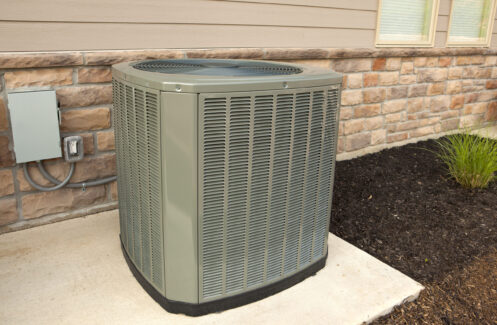
When temperatures rise in summer, reliance on air conditioning increases. This puts pressure on your HVAC system to keep your home cool and can cause reduced efficiency or breakdowns. You need a properly functioning system to keep your living space comfortable, so now’s the time to prepare it for summer. Here are dix practical tips you can use to make sure your HVAC system is ready for extreme heat.
1. Clean or Replace the Air Filters
HVAC systems have air filters that remove airborne dirt particles from the air flowing into the unit. After some time, the trapped dirt can block the pores, restricting the airflow. This causes the system to strain as it tries to draw in air and uses unnecessary energy.
You need to keep your air filter clean. If you’re not sure where it is, ask a professional HVAC technician to locate it and remove it for cleaning. Use low-pressure water from a garden hose, and aim it in the direction opposite to the airflow. You can also clean air filters in a sink or bucket filled with white vinegar and water. Let the filter soak for about an hour, then rinse it in clean water. Let it dry completely before replacing to prevent mold growth. If the filter is excessively dirty or damaged, you need to replace it.
Some types of air filters are meant to be replaced rather than cleaned. Depending on the type, you can replace the filter every one to three months or clean it every three weeks. Clean air filters not only ensure your system is operating efficiently but can also improve the quality of your indoor air.
2. Monitor the Refrigerant Level
The refrigerant is like blood for your HVAC system. It is responsible for the heat exchange process that keeps your home feeling cool. The refrigerant needs to be maintained at an adequate level, so the system can remain efficient and serve you for a long time.
There are some telltale signs that alert you of reduced refrigerant levels. For instance, you may notice a sudden increase in the energy bills. You can also experience weak airflow or warm air blowing from the vents. This happens because low refrigerant levels cause the evaporator coils to freeze, which limits heat exchange. When there is a leak, you may hear a hissing or bubbling sound as the refrigerant leaves the system.
Refrigerant is highly toxic, so it’s best to have a professional HVAC technician check the level for you. If it’s low, the expert will refill it with the required amount. If the refrigerant level it too high, it can be due to blockages in the system, and they will repair the problem.
3. Insulate Your Home
When the summer heat is extreme, you can adequately insulate your home to keep the heated outdoor air outside and prevent the cooled air from escaping from the unit. Adding insulation provides a thermal barrier that slows heat flow from the unconditioned space to the conditioned rooms. This saves the HVAC system from straining to provide adequate cooling.
For attic insulation, a professional can use batting or loose fill. The latter is cheaper and has better coverage when properly installed. To know whether you have adequate insulation in the attic, the pros will measure its thickness, and if it’s less than 13 inches, they may need to add some. They can eliminate air leaks by sealing any cracks and gaps in the attic before adding insulation.
Exterior walls require experts to replace the siding of the building and add insulation. They can use blow-in insulation that provides a high R-value. Adding it to the exterior walls prevents disruption of the indoor furnishing and décor. Alternatively, they can use injectable spray foam insulation, which is a more affordable option.
4. Inspect, Clean and Seal the Ductwork
The ductwork distributes cooled air throughout the house. The network of ducts should be inspected at least once every year for damage and dirt. A professional HVAC technician can repair leaks detected during the inspection to prevent air leakage. This can be done with heat-approved tape for damage on a flat surface where two pieces of metal connect. For areas that are hard to seal with foil tape, the technician can use mastic sealant, which is easier to apply and more effective.
Your ductwork may also need to be cleaned if you cannot see some distance into the duct when using a flashlight to illuminate the area. There may be dust, debris, mold or pest nests. Dirty ductwork can reduce your indoor air quality. When air flows through the ducts, it can collect and distribute harmful particles. If you have severe dirt and debris accumulation, you may notice uneven cooling, which can strain the system.
5. Use Smart Thermostats
The thermostat senses the room’s temperature and signals when the HVAC system should start or stop operating. You can upgrade to a smart model that gives you more control over the system. This Wi-Fi-enabled device can automatically adjust the temperature settings, so your home is cooled to the optimal temperature. Smart thermostats can learn your daily preferences and adjust the settings, so you do not have to do it manually.
These devices also give you a remote control of your system. This is helpful when you are away and forget to turn your HVAC off or to power-saving mode. You can also adjust the settings so the system cools your home in advance so you find it in good condition when you get home. Additionally, a smart thermostat can alert you when it is time for maintenance practices such as cleaning or replacing the air filters. When upgrading, hire a professional to swap the devices. They can help you place the new thermostat in an ideal location and ensure it is properly calibrated.
6. Clear the Area Around the Outdoor Unit
Your air conditioner has a condenser outside the house that enables the appliance to release heat more efficiently. When the refrigerant absorbs heat, the compressor pressurizes it and forces it through the outdoor condenser coils to release heat into the air outside. The cooled refrigerant then travels back inside to the evaporator.
If there are obstacles around the outdoor unit, it becomes harder for the refrigerant to release the heat. This increases the time needed to cool your home and uses more energy. Trim back any branches, bushes and weeds to leave at least 2 feet of clear space around the unit. Sweep away any debris, including animal droppings and leaves.
To clean the outdoor unit, you’ll need a technician who can remove dirt from the condenser fins using a vacuum cleaner attached to a soft brush. They can then spray a coil cleaner and wash it off with water about 15 minutes later.
You can also upgrade to a more energy-efficient system if your current one is past its expected lifespan or has proved unreliable despite adequately preparing it for the summer. Our professional HVAC technicians at Beyer Air Conditioning & Heating are trained to handle all work related to heating and air conditioning services. We help residents in San Antonio, TX to have a comfortable indoor environment regardless of the weather outside.
Contact our team at Beyer Air Conditioning & Heating when you need HAVC system installation, repair or maintenance.



